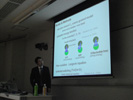
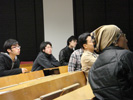
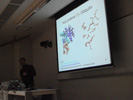
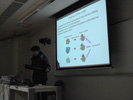
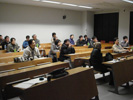






Kinesin is a motor protein that moves unidirectionally along a microtubule (MT) by using chemical energy produced by ATP hydrolysis, and is responsible for intracellular transport of vesicles. Roughly, kinesin motor could be categorized into two groups. One is conventional kinesin (kinesin-1) which is a representative of two-headed motor. This motor moves along MT such as human walking by working two heads in hand-over-hand fashion. Several experimental studies revealed that the inter-molecular interaction between two heads play an important role for welled coordinated stepping. The other is KIF1A which is a representative of one-head kinesin motor. Even with one-head, this motor can move unidirectionally along MT by producing biased Brownian motion. Fortunately, two major monomer structures (ATP type and ADP type) are available. However, kinesin-MT complex structures were still not resolved. Then, we tried to fit atomic models of kinesin into cryo-EM data (kinesin-MT complex) by flexible fitting approach which was mainly developed by Ishida (JAEA) to address MT-induced ATPase activity. About motility, how KIF1A generates the translational movement from chemical reaction cycle still remains to be elucidated. Then, in this work, to address this question we try to reproduce translational movement of KIF1A by coarse-grained simulation of the multiple-basin model that realizes conformational change during ATP hydrolysis cycle. We then found one condition that reproduces the biased Brownian movement. Namely, when a cargo (or a bead) with sufficiently large radius is attached to the C terminus of KIF1A, as in the in vivo situation, KIF1A exhibited the forward-biased Brownian movement along MT, in a consistent manner to experiments.
To elucidate the structural basis of the diversity and universality in protein-protein interactions, an exhaustive all-against-all structural comparison of all known protein interfaces in the Protein Data Bank was performed at atomic resolution. After clustering similar interfaces, approximately 20,000 structural motifs with at least two members were identified, out of which 3,678 motifs consisted of at least 10 interfaces. Except for some trivial interfaces involving single alpha helices, almost all motifs were found to be confined within single protein families. Furthermore, the interaction partners of each motif were found to be very limited, and accordingly, the interaction networks of the motifs tend to be small, and are much more restricted than the binding sites for small ligand molecules. These findings suggest that, at the level of atomic structures, protein-protein interactions are precisely designed, and hence, protein interfaces with multiple interacting partners should involve incompletely overlapping multiple interfaces and/or accommodate structural changes upon binding to their targets.
Recently, many three-dimensional structures of the ribosome at various functional states during the process of translating RNA to protein have been determined by cryo-electron microscopy (cryo-EM) and reconstruction techniques. Cryo-EM has the advantage in that the samples are in a near-to-native environment, and thus the reconstructed 3D structures from many cryo-EM 2D images are expected to reflect the native 3D structures in living systems. However, because of the low signal-to-noise ratio of the EM images, the resolution of the reconstructed structures is low.
In this study, we compare the 3D cryo-EM structures of the ribosome by using fitting techniques and normal mode analysis of an elastic network model of the ribosome. In the fitting technique, the entire atomic structure of the ribosome is translated and rotated as a rigid body so that it overlaps a 3D EM structure at the maximum ratio. The atomic structure of the ribosome solved by X-ray crystallography is then computationally deformed so that it fits the EM structures better. For this purpose, a normal mode analysis of the elastic network model was used. Deformed structures were generated by moving atoms in the ribosome along the directions of the normal mode vectors. Large movement of atoms, however, would destroy the local conformation, thus, only small deformation from the original structure was allowed. To generate structures with larger deformation, another normal mode analysis was performed on a newly generated structure, and the atomic positions were changed by the same process described above. In this way, a series of deformed structures were generated.
Large-scale ratchet-like deformations were observed in an EM structure of the initiation complex and in some EM structures bound with EFG, RF3, and RRF. In most of them, the L1 stalk, which interacts with the tRNA molecule at the E site of ribosome and is considered to be involved in the release of the tRNA, was in ‘‘the blocking state’’ for the E-tRNA. Furthermore, we found that the EM structures bound with EFG or RRF were aligned in the conformational space, suggesting that the large- scale conformational changes of the 70S ribosome bound with these factors occur along a specific pathway in a concerted manner.